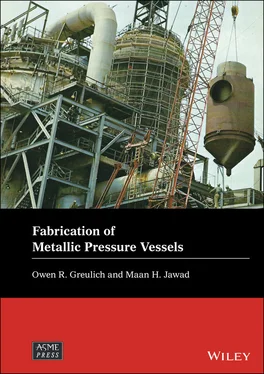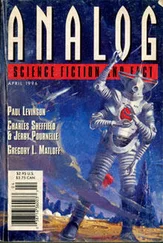Maan H. Jawad - Fabrication of Metallic Pressure Vessels
Здесь есть возможность читать онлайн «Maan H. Jawad - Fabrication of Metallic Pressure Vessels» — ознакомительный отрывок электронной книги совершенно бесплатно, а после прочтения отрывка купить полную версию. В некоторых случаях можно слушать аудио, скачать через торрент в формате fb2 и присутствует краткое содержание. Жанр: unrecognised, на английском языке. Описание произведения, (предисловие) а так же отзывы посетителей доступны на портале библиотеки ЛибКат.
- Название:Fabrication of Metallic Pressure Vessels
- Автор:
- Жанр:
- Год:неизвестен
- ISBN:нет данных
- Рейтинг книги:4 / 5. Голосов: 1
-
Избранное:Добавить в избранное
- Отзывы:
-
Ваша оценка:
- 80
- 1
- 2
- 3
- 4
- 5
Fabrication of Metallic Pressure Vessels: краткое содержание, описание и аннотация
Предлагаем к чтению аннотацию, описание, краткое содержание или предисловие (зависит от того, что написал сам автор книги «Fabrication of Metallic Pressure Vessels»). Если вы не нашли необходимую информацию о книге — напишите в комментариях, мы постараемся отыскать её.
A comprehensive guide to processes and topics in pressure vessel fabrication Fabrication of Metallic Pressure Vessels
Fabrication of Metallic Pressure Vessels
Fabrication of Metallic Pressure Vessels — читать онлайн ознакомительный отрывок
Ниже представлен текст книги, разбитый по страницам. Система сохранения места последней прочитанной страницы, позволяет с удобством читать онлайн бесплатно книгу «Fabrication of Metallic Pressure Vessels», без необходимости каждый раз заново искать на чём Вы остановились. Поставьте закладку, и сможете в любой момент перейти на страницу, на которой закончили чтение.
Интервал:
Закладка:
A vessel fabricated of certain nickel alloys, titanium, or zirconium, on the other hand, will have very high material costs. In this situation, reducing material costs may be effective in reducing overall costs.
Seeking only the lowest hourly rates risks, at times, finding the lowest productivity, but where skilled labor is acquired cheaply, overall product costs may be low.
Thus, it is important to assess the overall cost of a delivered product. When a design change is made, whether or not with the intent of reducing costs, overall costs must be reassessed. It will sometimes be found that the change results in even greater savings than anticipated, but it will also sometimes be found that the savings are eaten up by increases in other areas.
1.4 Fabrication of Nonnuclear Versus Nuclear Pressure Vessels
The fabrication of nuclear components such as vessels, pumps, valves, piping, and storage tanks in the United States must meet the requirements of Section III Division 1 of the ASME Boiler and Pressure Vessel Code as well as the rules of the U.S. Nuclear Regulatory Commission (NRC). This book is written for nonnuclear applications. While the general fabrication processes such as forming, machining, and welding are the same for both nonnuclear and nuclear components, the quality control process is different regarding the details of these operations.
Nuclear components constructed in accordance with the ASME code are considered in “classes” that are used to construct pressure equipment in accordance to its relative importance to safety. The three most common classes are Class 1, 2, and 3.
Class 1 components, including vessels such as reactor vessels, pressurizers and the primary side (tubes) of steam generators are exposed to radioactive coolant fluid, and they consequently are considered to bear the highest importance to safety. Class 1 vessels therefore require the most stringent levels of quality control for the various fabrication operations, compared to Class 2 and 3 vessels. Class 2 vessels generally resemble ASME VIII‐2 (editions prior to 2007) requirements, while Class 3 components are generally similar to VIII‐1 requirements.
All three classes of nuclear components are subject to strict quality control during construction. Quality assurance requirements for nuclear applications are provided in Article 4000 of the ASME Nuclear Code Subsection NCA (General Requirements for Division 1 and Division 2), along with its references to ASME NQA‐1 (Quality Assurance Requirements for Nuclear Facility Applications, Part I and Part II).
Some of the details required during fabrication of Class 1 nuclear vessels, pumps, valves, and piping are as follows:
1 All materials must be provided with documentation showing Certified Material Mill Test Reports. The location of the test specimens taken from the mill plate must be identified for traceability. When a piece of the mill plate is cut out for use as a vessel part, its location in the mill plate is recorded and identified. Depending on the material, the method of removing the plate, such as machining or burning then grinding, may need to be recorded. The type and identification number of the grinding wheel may also need to be recorded. These requirements must be met for each piece of material in the pressure vessel.
2 Hot forming during fabrication must be qualified and documented. The effect of hot forming on material properties and final thickness for some materials may have to be recorded.
3 All weld electrodes and wires must be identified, including recording of heat numbers, location where used, and properties, with full documentation and traceability.
4 Each weld in the vessel must be identified with regard to the location as well as WPS and PQR.
5 All weld repairs on materials and welds during fabrication must be identified and documented. Such documentation must include weld procedures and their effect on properties such as strength and impact values.
6 Examination of welds and components must be documented.
7 Records of operators, equipment used, calibration of equipment, and results of tests must be maintained.
This limited sample of Class 1 requirements illustrates the extent to which quality control and documentation required for nuclear components exceed those for nonnuclear components.
1.5 Units and Abbreviations
This section describes the unit conventions used in this book. Consistency of units is important in communicating technical data. While throughout the engineering field there is generally good comprehension of units, conversions, and their use, various industries and companies have their own conventions. This can result in confusion, mistakes, and accidents. An example is when NASA lost a 125‐million‐dollar Mars Climate Orbiter when the navigation team at JPL used the customary NASA metric units in its calculations of acceleration readings while Lockheed Martin that built the spacecraft provided the vital acceleration data in the English units. And as the Los Angeles Times put it, “In a sense, the spacecraft was lost in translation.”
Rates will use abbreviations, not followed by a period, and a slash rather than “per.” Example: “inches per minute” will be written as “in./min”, and in metric “mm/min.”
While in machining the cutting speed is generally referred to as “surface feet per minute,” for consistency with other sections this will be written as “ft/min” with no periods at the ends of the abbreviations.
“Micro” will be represented by the lowercase Greek letter mu, written as μ.
English units will be used, followed by the metric equivalent. Dimensions will generally be rounded when converted, and will show no more than three significant figures. For example, “6 in.” becomes “150 mm.” This convention will be followed unless something is clearly intended as an exact dimension or for nominal sizes that are clearly not rounded measurements of the specified dimension. Thus, 6 in. plate is written as 150 mm, and 6 in. pipe is written as DN 150. 3/4 in. plate is written as 19 mm plate.
Appendix A provides a list of abbreviations and conversions commonly used in the pressure vessel industry.
1.6 Summary
The description in this chapter represents a brief summary of the many tasks that must be accomplished in the fabrication and preparation of a pressure vessel, as well as some discussion of aspects of cost reduction. This description and associated cost control techniques can be applied both to less and more complex vessels. The same issues occur and the same processes are applied. The following chapters provide a more detailed look at each aspect of this process, and the appendices provide a compendium of information that is often needed during the design or production of pressure vessels.
Конец ознакомительного фрагмента.
Текст предоставлен ООО «ЛитРес».
Прочитайте эту книгу целиком, купив полную легальную версию на ЛитРес.
Безопасно оплатить книгу можно банковской картой Visa, MasterCard, Maestro, со счета мобильного телефона, с платежного терминала, в салоне МТС или Связной, через PayPal, WebMoney, Яндекс.Деньги, QIWI Кошелек, бонусными картами или другим удобным Вам способом.
Интервал:
Закладка:
Похожие книги на «Fabrication of Metallic Pressure Vessels»
Представляем Вашему вниманию похожие книги на «Fabrication of Metallic Pressure Vessels» списком для выбора. Мы отобрали схожую по названию и смыслу литературу в надежде предоставить читателям больше вариантов отыскать новые, интересные, ещё непрочитанные произведения.
Обсуждение, отзывы о книге «Fabrication of Metallic Pressure Vessels» и просто собственные мнения читателей. Оставьте ваши комментарии, напишите, что Вы думаете о произведении, его смысле или главных героях. Укажите что конкретно понравилось, а что нет, и почему Вы так считаете.











